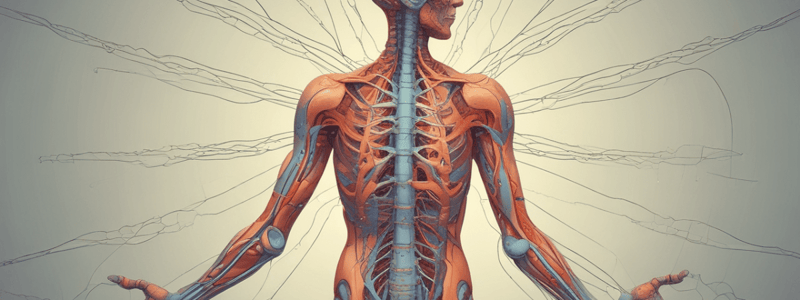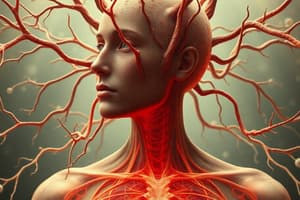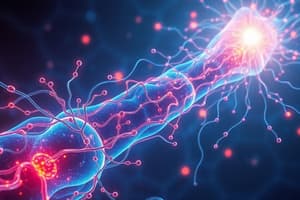Podcast
Questions and Answers
What is somatosensation?
What is somatosensation?
- The sense of the body, including electromagnetism
- The sense of the body, including vision and hearing
- The sense of the body, including smell and taste
- The sense of the body, including position sense, vibration sense, touch, pain, and temperature (correct)
What type of somatosensory receptors detect physical forces?
What type of somatosensory receptors detect physical forces?
- Nociceptors
- Photoreceptors
- Thermoreceptors
- Mechanoreceptors (correct)
Where can somatosensory receptors be found in the body?
Where can somatosensory receptors be found in the body?
- Only in the skin
- In the skin and deep tissues (correct)
- In the brain only
- Only in deep tissues
What type of somatosensory neurons carry information related to position sense, vibration sense, and some touch information?
What type of somatosensory neurons carry information related to position sense, vibration sense, and some touch information?
What is the function of mechanoreceptors in deep tissues?
What is the function of mechanoreceptors in deep tissues?
What type of somatosensory receptors have structures on the end of axons?
What type of somatosensory receptors have structures on the end of axons?
Where are the somas of most somatosensory neurons located?
Where are the somas of most somatosensory neurons located?
What type of information do nociceptors and thermoreceptors detect?
What type of information do nociceptors and thermoreceptors detect?
What is the primary function of somatosensory receptors in the peripheral nervous system?
What is the primary function of somatosensory receptors in the peripheral nervous system?
Which type of somatosensory receptors are responsible for detecting noxious stimuli?
Which type of somatosensory receptors are responsible for detecting noxious stimuli?
What is the characteristic of somatosensory receptors in the skin?
What is the characteristic of somatosensory receptors in the skin?
What is the function of somatosensory neurons in the peripheral nervous system?
What is the function of somatosensory neurons in the peripheral nervous system?
Which type of axons are associated with the transmission of position sense, vibration sense, and some touch information?
Which type of axons are associated with the transmission of position sense, vibration sense, and some touch information?
What is the characteristic of nociceptors and thermoreceptors?
What is the characteristic of nociceptors and thermoreceptors?
What is the role of somatosensory neurons in the somatosensory system?
What is the role of somatosensory neurons in the somatosensory system?
Which type of somatosensory receptors detect stretch of skeletal muscle?
Which type of somatosensory receptors detect stretch of skeletal muscle?
What is the primary function of mechanoreceptors in the skin?
What is the primary function of mechanoreceptors in the skin?
What type of somatosensory receptors are more prevalent in deep tissues?
What type of somatosensory receptors are more prevalent in deep tissues?
What is the characteristic of large-diameter axons with thick myelin sheaths?
What is the characteristic of large-diameter axons with thick myelin sheaths?
What is the main difference between mechanoreceptors and nociceptors?
What is the main difference between mechanoreceptors and nociceptors?
What is the function of afferent neurons in the somatosensory system?
What is the function of afferent neurons in the somatosensory system?
How do somatosensory receptors in the skin and deep tissues differ?
How do somatosensory receptors in the skin and deep tissues differ?
What is the characteristic of somatosensory neurons that carry information related to position sense, vibration sense, and some touch information?
What is the characteristic of somatosensory neurons that carry information related to position sense, vibration sense, and some touch information?
What is the role of somatosensory receptors in the peripheral nervous system?
What is the role of somatosensory receptors in the peripheral nervous system?
Study Notes
Somatosensation in the Peripheral Nervous System
- Somatosensation refers to the senses of the body, including five senses: position sense, vibration sense, touch, pain, and temperature.
- These senses are useful for medical purposes because they can be tested on examination.
Somatosensory Receptors
- Somatosensory receptors detect stimuli and send information to the central nervous system.
- There are many types of somatosensory receptors, categorized into:
- Mechanoreceptors: respond to physical forces, detecting position, vibration, and touch.
- Nociceptors: detect noxious stimuli, creating the experience of pain.
- Thermoreceptors: detect temperature.
Somatosensory Receptors in the Body
- Somatosensory receptors can be found in:
- Skin: mechanoreceptors detect mechanical stimuli, including position, vibration, and touch.
- Deep tissues: mechanoreceptors detect stretch of skeletal muscle, important for position sense.
Types of Mechanoreceptors
- Mechanoreceptors in the skin:
- Detect mechanical stimuli, including vibration and touch.
- Have structures on the end of axons.
- Mechanoreceptors in deep tissues:
- Detect stretch of skeletal muscle, important for position sense.
- Have a specific structure, like the one in muscle.
Nociceptors and Thermoreceptors
- Nociceptors and thermoreceptors:
- Detect pain and temperature.
- Are usually bare nerve endings, without structures at the end of axons.
Somatosensory Neurons
- Somatosensory neurons carry information from somatosensory receptors to the central nervous system.
- Afferent neurons carrying somatosensory information are called somatosensory neurons.
- Most somatosensory neurons have their somas in ganglia close to the spinal cord or brainstem.
Types of Somatosensory Neurons
- Different types of somatosensory information travel in different types of somatosensory neurons:
- Position sense, vibration sense, and some touch information travel in large-diameter axons with thick myelin sheaths.
- Pain, temperature, and the rest of touch information travel in small-diameter axons with thin or no myelin sheaths.
- The speed of conduction of action potentials depends on the diameter and myelin sheath of the axon:
- Large-diameter axons with thick myelin sheaths conduct action potentials rapidly.
- Small-diameter axons with thin or no myelin sheaths conduct action potentials more slowly.
Touch Sense
- The sense of touch is a combination of:
- Fine touch sense: precise touch information that travels in fast somatosensory neurons.
- Gross touch sense: less precise touch information that travels in slower somatosensory neurons.
Somatosensation in the Peripheral Nervous System
- Somatosensation refers to the senses of the body, including position sense, vibration sense, touch, pain, and temperature.
- These senses are useful for medical purposes because they can be tested on examination.
Somatosensory Receptors
- Somatosensory receptors detect stimuli and send information to the central nervous system.
- There are three main categories of somatosensory receptors:
- Mechanoreceptors: respond to physical forces, detecting position, vibration, and touch.
- Nociceptors: detect noxious stimuli, creating the experience of pain.
- Thermoreceptors: detect temperature.
Somatosensory Receptors in the Body
- Somatosensory receptors can be found in:
- Skin: mechanoreceptors detect mechanical stimuli, including position, vibration, and touch.
- Deep tissues: mechanoreceptors detect stretch of skeletal muscle, important for position sense.
Types of Mechanoreceptors
- Mechanoreceptors in the skin:
- Detect mechanical stimuli, including vibration and touch.
- Have structures on the end of axons.
- Mechanoreceptors in deep tissues:
- Detect stretch of skeletal muscle, important for position sense.
- Have a specific structure, like the one in muscle.
Nociceptors and Thermoreceptors
- Nociceptors and thermoreceptors:
- Detect pain and temperature.
- Are usually bare nerve endings, without structures at the end of axons.
Somatosensory Neurons
- Somatosensory neurons carry information from somatosensory receptors to the central nervous system.
- Afferent neurons carrying somatosensory information are called somatosensory neurons.
- Most somatosensory neurons have their somas in ganglia close to the spinal cord or brainstem.
Types of Somatosensory Neurons
- Different types of somatosensory information travel in different types of somatosensory neurons:
- Position sense, vibration sense, and some touch information travel in large-diameter axons with thick myelin sheaths.
- Pain, temperature, and the rest of touch information travel in small-diameter axons with thin or no myelin sheaths.
- The speed of conduction of action potentials depends on the diameter and myelin sheath of the axon:
- Large-diameter axons with thick myelin sheaths conduct action potentials rapidly.
- Small-diameter axons with thin or no myelin sheaths conduct action potentials more slowly.
Touch Sense
- The sense of touch is a combination of:
- Fine touch sense: precise touch information that travels in fast somatosensory neurons.
- Gross touch sense: less precise touch information that travels in slower somatosensory neurons.
Somatosensation in the Peripheral Nervous System
- Somatosensation refers to the senses of the body, including position sense, vibration sense, touch, pain, and temperature.
- These senses are useful for medical purposes because they can be tested on examination.
Somatosensory Receptors
- Somatosensory receptors detect stimuli and send information to the central nervous system.
- There are three main categories of somatosensory receptors:
- Mechanoreceptors: respond to physical forces, detecting position, vibration, and touch.
- Nociceptors: detect noxious stimuli, creating the experience of pain.
- Thermoreceptors: detect temperature.
Somatosensory Receptors in the Body
- Somatosensory receptors can be found in:
- Skin: mechanoreceptors detect mechanical stimuli, including position, vibration, and touch.
- Deep tissues: mechanoreceptors detect stretch of skeletal muscle, important for position sense.
Types of Mechanoreceptors
- Mechanoreceptors in the skin:
- Detect mechanical stimuli, including vibration and touch.
- Have structures on the end of axons.
- Mechanoreceptors in deep tissues:
- Detect stretch of skeletal muscle, important for position sense.
- Have a specific structure, like the one in muscle.
Nociceptors and Thermoreceptors
- Nociceptors and thermoreceptors:
- Detect pain and temperature.
- Are usually bare nerve endings, without structures at the end of axons.
Somatosensory Neurons
- Somatosensory neurons carry information from somatosensory receptors to the central nervous system.
- Afferent neurons carrying somatosensory information are called somatosensory neurons.
- Most somatosensory neurons have their somas in ganglia close to the spinal cord or brainstem.
Types of Somatosensory Neurons
- Different types of somatosensory information travel in different types of somatosensory neurons:
- Position sense, vibration sense, and some touch information travel in large-diameter axons with thick myelin sheaths.
- Pain, temperature, and the rest of touch information travel in small-diameter axons with thin or no myelin sheaths.
- The speed of conduction of action potentials depends on the diameter and myelin sheath of the axon:
- Large-diameter axons with thick myelin sheaths conduct action potentials rapidly.
- Small-diameter axons with thin or no myelin sheaths conduct action potentials more slowly.
Touch Sense
- The sense of touch is a combination of:
- Fine touch sense: precise touch information that travels in fast somatosensory neurons.
- Gross touch sense: less precise touch information that travels in slower somatosensory neurons.
Somatosensation in the Peripheral Nervous System
- Somatosensation refers to the senses of the body, including position sense, vibration sense, touch, pain, and temperature.
- These senses are useful for medical purposes because they can be tested on examination.
Somatosensory Receptors
- Somatosensory receptors detect stimuli and send information to the central nervous system.
- There are three main categories of somatosensory receptors:
- Mechanoreceptors: respond to physical forces, detecting position, vibration, and touch.
- Nociceptors: detect noxious stimuli, creating the experience of pain.
- Thermoreceptors: detect temperature.
Somatosensory Receptors in the Body
- Somatosensory receptors can be found in:
- Skin: mechanoreceptors detect mechanical stimuli, including position, vibration, and touch.
- Deep tissues: mechanoreceptors detect stretch of skeletal muscle, important for position sense.
Types of Mechanoreceptors
- Mechanoreceptors in the skin:
- Detect mechanical stimuli, including vibration and touch.
- Have structures on the end of axons.
- Mechanoreceptors in deep tissues:
- Detect stretch of skeletal muscle, important for position sense.
- Have a specific structure, like the one in muscle.
Nociceptors and Thermoreceptors
- Nociceptors and thermoreceptors:
- Detect pain and temperature.
- Are usually bare nerve endings, without structures at the end of axons.
Somatosensory Neurons
- Somatosensory neurons carry information from somatosensory receptors to the central nervous system.
- Afferent neurons carrying somatosensory information are called somatosensory neurons.
- Most somatosensory neurons have their somas in ganglia close to the spinal cord or brainstem.
Types of Somatosensory Neurons
- Different types of somatosensory information travel in different types of somatosensory neurons:
- Position sense, vibration sense, and some touch information travel in large-diameter axons with thick myelin sheaths.
- Pain, temperature, and the rest of touch information travel in small-diameter axons with thin or no myelin sheaths.
- The speed of conduction of action potentials depends on the diameter and myelin sheath of the axon:
- Large-diameter axons with thick myelin sheaths conduct action potentials rapidly.
- Small-diameter axons with thin or no myelin sheaths conduct action potentials more slowly.
Touch Sense
- The sense of touch is a combination of:
- Fine touch sense: precise touch information that travels in fast somatosensory neurons.
- Gross touch sense: less precise touch information that travels in slower somatosensory neurons.
Studying That Suits You
Use AI to generate personalized quizzes and flashcards to suit your learning preferences.
Description
Explore the senses of the body, including position sense, vibration sense, touch, pain, and temperature, and learn about somatosensory receptors and their role in the peripheral nervous system.




